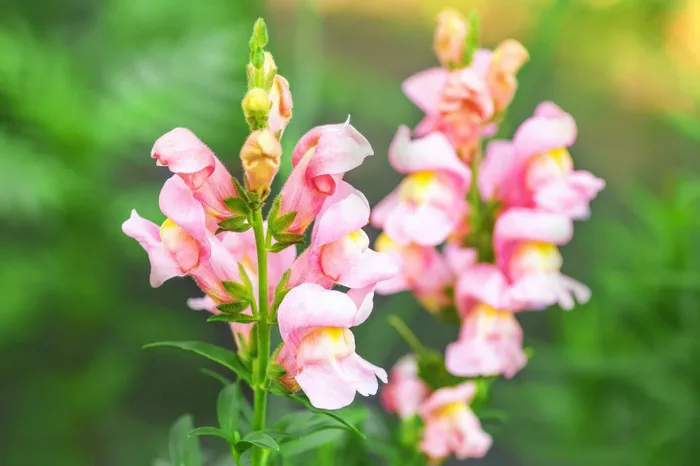Snapdragon flowers, known scientifically as Antirrhinum, are captivating blooms that have intrigued botanists, gardeners, and flower enthusiasts for centuries. With their unique appearance and intriguing structure, snapdragons have become a favorite in gardens, bouquets, and floral arrangements worldwide. In this article, we delve into the precise characteristics and visual allure of the Snapdragon flower, uncovering its secrets and shedding light on its mesmerizing beauty.
Understanding the Snapdragon Flower: A Visual Exploration
Snapdragon flowers boast a distinctive appearance characterized by their spiky blooms and distinctive mouth-like petals. These flowers belong to the genus Antirrhinum, which encompasses roughly 40 species, varying in size, color, and form. However, certain defining features remain consistent across most Snapdragon varieties, offering observers a fascinating visual spectacle.
Structure and Anatomy
The Snapdragon flower’s structure is intricate, with each component serving a specific function in the plant’s reproductive process. At the center of the flower lies the reproductive organs, comprising the stigma, style, and stamens. Surrounding these essential parts are the petals, which give the Snapdragon its vibrant and alluring appearance.
The petals of a Snapdragon flower are arranged in a unique manner, resembling a dragon’s head when gently squeezed from the sides. This distinctive trait is the origin of the flower’s common name, as the petals appear to open and close like the mouth of a mythical creature.
Color Variations
One of the most enchanting aspects of Snapdragon flowers is their diverse range of colors. These blooms are available in a spectrum of hues, including but not limited to:
1. Vibrant Reds and Oranges: Many Snapdragon varieties showcase striking red and orange tones, evoking feelings of warmth and vitality.
2. Soft Pastels: From delicate pinks to serene lavenders, pastel-colored Snapdragons exude a sense of tranquility and grace.
3. Bright Yellows and Whites: Some Snapdragons feature bright yellow or white petals, adding a touch of brightness and purity to any garden or floral arrangement.
4. Bi-color and Multi-color Varieties: Certain Snapdragon cultivars boast bi-color or multi-color petals, creating captivating patterns and visual interest.
The diverse color palette of Snapdragon flowers allows for endless possibilities in garden design and floral compositions, making them a versatile choice for both amateur and seasoned gardeners alike.
Size and Growth Habits
Snapdragon plants vary in size and growth habits, offering flexibility in landscaping and garden planning. While some varieties are compact and ideal for borders or containers, others may grow tall and stately, making them suitable for backdrops or focal points in garden beds.
The height of Snapdragon plants typically ranges from 6 inches to 3 feet, depending on the cultivar and growing conditions. Additionally, certain varieties exhibit a bushy growth habit, while others may have a more upright or sprawling form.
Cultural Significance and Symbolism
Beyond their visual appeal, Snapdragon flowers hold cultural significance and symbolic meanings in various societies around the world. In Victorian England, for instance, Snapdragons were associated with deception and graciousness, reflecting the flower’s ability to open and close like a mouth.
In contemporary times, Snapdragon flowers are often used to convey messages of strength, resilience, and grace. Their striking appearance and adaptable nature make them a popular choice for floral arrangements in weddings, celebrations, and other special occasions.
Caring for Snapdragon Flowers
To ensure the health and vitality of Snapdragon flowers, proper care and maintenance practices are essential. Here are some tips for cultivating thriving Snapdragon plants:
1. Sunlight: Snapdragon flowers thrive in full sun or partial shade, so it’s important to plant them in a location where they receive adequate sunlight throughout the day.
2. Soil: These flowers prefer well-drained soil with a slightly acidic to neutral pH. Amending the soil with organic matter such as compost can improve its texture and fertility.
3. Watering: While Snapdragon plants require regular watering, it’s important to avoid overwatering, as excessive moisture can lead to root rot and other issues. Water the plants deeply when the top inch of soil feels dry to the touch.
4. Fertilization: Apply a balanced fertilizer to Snapdragon plants every 4-6 weeks during the growing season to promote healthy growth and abundant flowering.
5. Deadheading: To encourage continuous blooming, remove spent flowers promptly by pinching or cutting them off at the base of the stem. This practice prevents the plant from expending energy on seed production and encourages the development of new blooms.
By following these care guidelines, gardeners can enjoy vibrant and thriving Snapdragon flowers throughout the growing season, adding beauty and charm to their outdoor spaces.
Conclusion
The Snapdragon flower is a captivating botanical specimen renowned for its unique appearance, diverse color palette, and cultural significance. With its spiky blooms and mouth-like petals, the Snapdragon stands out as a symbol of resilience, grace, and beauty in gardens and floral arrangements worldwide. Whether adorning a bouquet, brightening a garden bed, or conveying heartfelt sentiments, Snapdragon flowers continue to enchant and inspire all who encounter them, embodying nature’s timeless allure and endless creativity.


